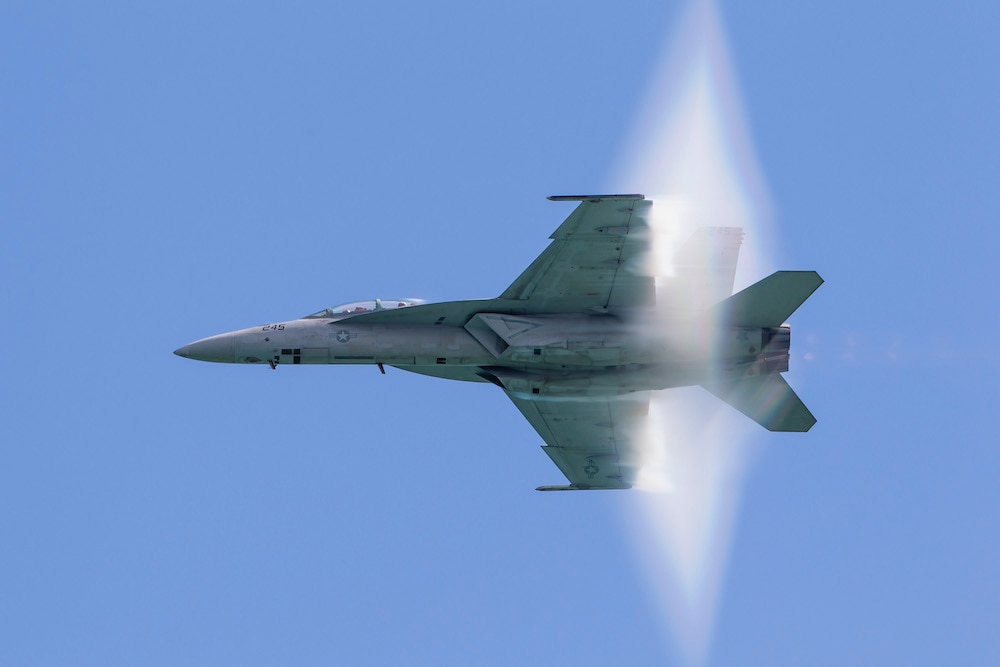Create a free profile to get unlimited access to exclusive videos, sweepstakes, and more!
F-16s Intercepting Cessna Create Sonic Boom Over Washington D.C.
We prefer our sonic booms on TV.

A sonic boom shook the District of Columbia and surrounding areas on Sunday, June 4, prompting public concern and a statement from the FAA. The sound and associated vibrations were the result of two F-16 fighter jets taking off from Joint Base Andrews in Maryland, which were scrambled in response to a private Cessna plane that violated U.S. Government airspace.
WHAT ARE SONIC BOOMS?
Any object traveling through the atmosphere causes a change in air pressure as it moves through a space. Air in front of the object is compressed, causing increased air pressure at the front. This is true whether the object is a bullwhip, a bullet, or a military aircraft. Pressure waves build up at the front of the object, in the case of an F-16 fighter jet, that's the nose, and they trail back toward the tail of the aircraft similar to the way water waves break over the front of a ship and trail along the sides and behind.
RELATED: Building an Interstellar Ramjet Might be Possible, But Insanely Difficult
Those compression waves travel away from an aircraft at the speed of sound such that subsonic aircraft never catch up with them. However, as an aircraft speeds up and the distance between its speed and the speed of sound decreases, those compression waves start to stack up until they merge into a single shockwave traveling at the speed of sound. That is a sonic boom. We often think of them as occurring at the moment an aircraft or other object breaks the sound barrier, but they are actually a continuous phenomenon, as long as the object remains supersonic, which can be heard by observers along the flight path, as long as they are inside of the cone-shaped shockwave.
Sonic booms from large aircraft can be disruptive, startling, and can cause damage to structures. For those reasons, supersonic flight over residential areas is typically prohibited, though it can't always be avoided, as evidenced by the boom over D.C. on June 4.
WHAT CAUSED THE SONIC BOOM OVER WASHINGTON, D.C.?
The two F-16s from Joint Base Andrews were part of a complement of six total aircraft, scrambled from bases in Maryland, New Jersey, and South Carolina, in response to an incident involving a Cessna 560 Citation V. The two F-16s leaving from JBA were authorized to utilize supersonic speeds during the response, causing the sonic boom which rippled out over D.C., Maryland, and Virginia.
The Cessna took off from Elizabethton Municipal Airport in Tennessee, with three passengers and a pilot on a trip to the Long Island MacArthur Airport, in New York. An aircraft matching the Cessna’s description successfully arrived at its destination in New York before turning around and flying over the D.C. area, according to the flight tracking website Flight Aware. During the flight, the pilot did not respond to multiple attempts of contact, prompting a military response.
Two F-16s rendezvoused with the aircraft and made initial contact. For roughly half an hour, they attempted to communicate with the pilot through a combination of flares and aerial maneuvers, to no avail. During inspection of the plane, the F-16 pilots confirmed that the Cessna’s pilot appeared unresponsive and “slumped over” in their chair. Ultimately, the plane crashed in a mountainous area near Montebello, Virginia, killing the pilot and three passengers.
The plane was registered to Encore Motors of Melbourne, a company based in Florida and owned by John Rumpel. In a phone interview, Rumpel stated his family was aboard the plane, including his daughter, young granddaughter, and a nanny, according to The New York Times.
At present, it is unclear why the pilot was unresponsive, but it’s possible the cabin lost pressure, causing hypoxia or oxygen deprivation, resulting in everyone onboard losing consciousness. Witnesses speaking with The Washington Post on condition of anonymity said the plane went almost straight down at a high rate of speed, causing an impact crater and wreckage spread over 150 yards. Investigation into the incident is ongoing.
Catch all your sci-fi favorites from Battlestar Galactica and Farscape to Resident Alien and The Ark, streaming now on Peacock!


























